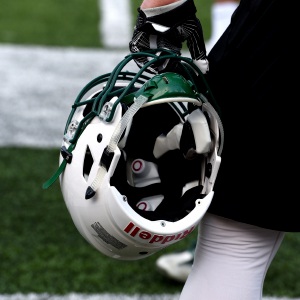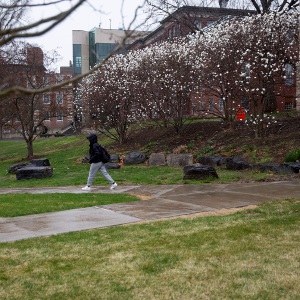A rickety dam means Goose Pond will be mostly drained
| Published: 05-30-2022 11:09 PM |
CANAAN — This may well be one of the last summers to enjoy Goose Pond before it is drained down to a 15-foot pool as the New Hampshire Department of Environmental Services repairs its dam.
“Nobody’s thrilled. The scope of this project is enormous,” said Michael Riese, the president of the Goose Pond Lake Association. “… But if in fact the dam did breach, it would be catastrophic downstream.”
The 31-foot-tall dam holds back the lake, which spans Hanover and Canaan. If water overpowered the dam, Mascoma Lake might be able to absorb some of the overflow. But the water could easily barrel into Lebanon, putting human lives at risk, said Corey Clark, an engineer in the Dam Bureau of the New Hampshire Department of Environmental Services, known as NHDES.
The dam standing today was built in 1918. Damming has turned a small natural pond into a 618-acre lake. Repairs and modifications over the decades, some of which also required NHDES to drain much of the lake, have not been enough to secure it. The dam is cracked, with water leaking through the century-old concrete. Water seeping below and around the dam could erode the soil away and flood through the dam, Clark explained.
NHDES plans to widen and stabilize the dam, installing deep wells to capture any seepage. NHDES is set to drain the lake this winter to repair the dam and then finish the concrete work the following fall. And with success, NHDES won’t be back for at least 50 years, Clark said.
“In order to pull this off, we need to get rid of the water,” he said.
NHDES will drain the pond 22 feet — a significant drop in a water body where the average depth is just 10 feet. In the winter, NHDES typically drops the pond by about 8 feet.
The project will “possibly be wrapped up in a year” if it proceeds according to plan, Clark said.
Article continues after...
Yesterday's Most Read Articles
 Football helmet maker buys Lebanon’s Simbex
Football helmet maker buys Lebanon’s Simbex
 James Parker granted parole for his role in Dartmouth professors’ stabbing deaths
James Parker granted parole for his role in Dartmouth professors’ stabbing deaths
 Zantop daughter: ‘I wish James' family the best and hope that they are able to heal’
Zantop daughter: ‘I wish James' family the best and hope that they are able to heal’
 Kenyon: Dartmouth alumni join union-busting effort
Kenyon: Dartmouth alumni join union-busting effort
 Parker up for parole more than 2 decades after Dartmouth professor stabbing deaths
Parker up for parole more than 2 decades after Dartmouth professor stabbing deaths
 Through new school partnerships, CRREL seeks to educate young scientists
Through new school partnerships, CRREL seeks to educate young scientists
If the contractor had to repair the dam without draining so much of the lake, the repairs could take as much as three years, and the cost — already estimated at $4.2 million — would climb even higher, he said. Draining the lake will also help the contractor work safely.
Riese and other concerned residents approached NHDES to ask if it would consider building a cofferdam — a watertight enclosure around the main dam that could be pumped dry as contractors worked on the dam. That way, the lake could remain full, Riese explained.
But Clark explained that a cofferdam was a no-go. Building a second dam to fix the original one could double the cost of the repairs, he said. The project would also stretch the project across at least three years: one season to build the cofferdam, another to repair the original and a third to remove the cofferdam.
Before the repairs begin, the state will analyze the potential impact on the environment. But the NHDES Wetlands Bureau does not have the authority to tell a dam owner not to drain a lake, Clark said. The agency will likely focus on the impact to wetlands adjacent to the dam and the consequences of extending the concrete further downstream. NHDES will also make sure to notify New Hampshire Fish and Game in case it wants to rescue any fish before the lake disappears around them.
For Riese, one the main concerns is how long the turtles, salamanders and fish will take to recover. Loons nest on the shores and spend their summers on Goose Pond. Once it is drained, they will have to find another home.
“Nature heals itself,” Riese said, but how quickly? No studies have looked at that yet, according to Clark.
“(Goose Pond) is high in the watershed, so there will possibly be two years of significant impact. It will take a while to refill,” Clark said.
A drought could prolong the impact. When NHDES drained Grafton Pond, it took years to refill, Clark said. That was in part because NHDES let water flow downstream to relieve Lebanon during a drought rather than save it to refill the pond. The pond has since refilled.
While Riese wishes that there was another way to fix the dam, he understands that the repairs are necessary.
“How can I or any of the residents be selfish about losing boating for a year when there’s potential loss of life? Most of us are resigned to the facts,” Riese said.
Looking on the bright side, he is interested to expose the remnants of old foundations and a road that were built before the river was dammed.
“It would be cool to see some of that,” he said.
And he may take the repairs as an opportunity to go to Alaska with his wife.
On a warm May day, Mark and Andrea Farnham, of Lebanon, checked in on the demolition work on their lakefront property on Goose Pond. They bought a small seasonal camp in 2000, and now they are replacing it with a single-wide modular home fit for all seasons. They plan to use their new home during the repairs.
While some of his neighbors wish that NHDES could repair the dam in more quickly, Farnham is glad the state is taking care of the dam.
“I’d rather have the dam done properly and stand for 40 years than slapdash so they have to do it again in five years,” he said. “They’re planning something semi-permanent.”
Claire Potter is a Report for America corps member. She can be reached at cpotter@vnews.com or 603-727-3242.


